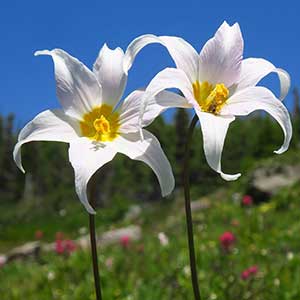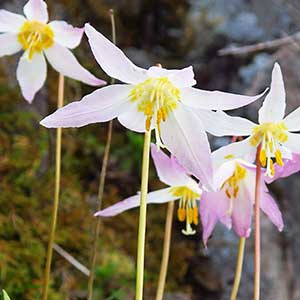Erythronium montanum
Erythronium elegans
avalanche-lily, white avalanche-lily, white glacier lily
Coast Range fawn lily, elegant fawn-lily
narrowly ovoid, 25–60 mm.
slender, 30–50 mm.
10–20 cm;
blade green, ovate to broadly lanceolate, base ± abruptly narrowed to petiole, margins wavy.
7–20 cm;
blade green or faintly mottled with brown or white, narrowly ovate, margins often wavy.
12–35 cm.
10–30 cm.
1–3-flowered.
1–2(–4)-flowered.
tepals white to creamy white with bright yellow zone at base, broadly ovate to broadly lanceolate, 25–45 mm, inner wider than outer, auriculate at base, length less than 4 times width;
stamens 12–24 mm;
filaments white, linear, slender, less than 0.8 mm wide;
anthers bright yellow;
style white, 13–25 mm;
stigma with slender, usually recurved lobes 1–5 mm.
tepals: inner ± white, outer ± white and tinged (often strongly) with pink, especially abaxially and along midline, becoming more generally pinkish with age, both inner and outer with yellow band at base, lanceolate to narrowly elliptic, 20–40 mm, abaxial surfaces and outer tepals often darker, inner auriculate at base;
stamens 13–22 mm;
filaments white, flattened, slightly widened, linear to lanceolate, 0.8–2 mm wide;
anthers yellow;
style white, 10–20 mm;
stigma with slender, usually recurved lobes 2–4 mm.
oblong, 3–6 cm.
obovoid to oblong, 2–5 cm.
= 24.
= 48.
Erythronium montanum
Erythronium elegans
This species occurs in the Coast Ranges of southern British Columbia, and disjunctly to southern Vancouver Island, the Olympic Peninsula, and Cascade Mountains from Mount Rainier National Park in Washington to central Oregon.
(Discussion copyrighted by Flora of North America; reprinted with permission.)
Of conservation concern.
This species is endemic to the Coast Ranges of western Oregon.
(Discussion copyrighted by Flora of North America; reprinted with permission.)



